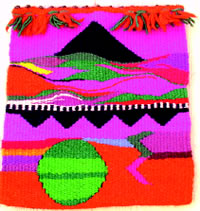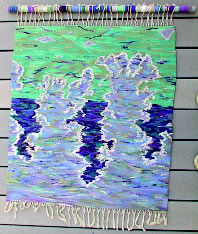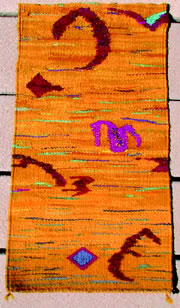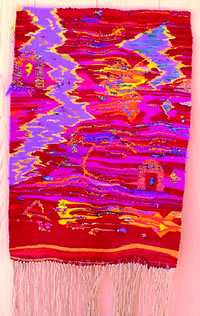|  About
10 years ago, Naya Raines woke with a start, sat upright,
and said out loud: “I think I need to weave.”
She had not consciously desired to weave or seriously considered
weaving before this sudden outburst. Shortly thereafter, she
took a Navajo weaving workshop on the reservation which she
lived. And although over the years she has appropriated new
methods, techniques and styles, she has continued to weave
with passion and a love for the art until this day. About
10 years ago, Naya Raines woke with a start, sat upright,
and said out loud: “I think I need to weave.”
She had not consciously desired to weave or seriously considered
weaving before this sudden outburst. Shortly thereafter, she
took a Navajo weaving workshop on the reservation which she
lived. And although over the years she has appropriated new
methods, techniques and styles, she has continued to weave
with passion and a love for the art until this day.
Weaving is virtually as old and as enduring as human civilization
itself. There is evidence that the Egyptians, 5000 years ago,
made special tapestries for the pharaohs in select colors
and patterns signifying their royal and spiritual heritage.
Ancient Greek pottery, from 540 BCE, portrays women weaving
cloth on large looms in the name of Athena, goddess of weaving
as well as war. The Navajo, or the Diné people, learned
weaving from Pueblo refugees in the late seventeenth century,
but quickly developed their own style and refinements to the
craft of weaving, allowing their weavings to express their
stories, histories and their culture.
 Like
the Navajo, from which she learned to weave, Raines appreciates
weaving as a holistic process, combining mind, body, emotions
and spirit into the craft. The art of weaving express her
self, her story and her environment. For example, Raines began
working on “ Ciaramallow’s Dream” while
she lived at the ocean. The colors and the forms started out
as ocean waves: the blues and purples smeared together like
the many colors of the ocean and the interplay of light. Wave
forms appeared on the tapestry in the form of white, bubbling
crests. In mid-tapestry, Raines moved to the Southwest, where
she continued the tapestry. A transformation happened, however,
and her Like
the Navajo, from which she learned to weave, Raines appreciates
weaving as a holistic process, combining mind, body, emotions
and spirit into the craft. The art of weaving express her
self, her story and her environment. For example, Raines began
working on “ Ciaramallow’s Dream” while
she lived at the ocean. The colors and the forms started out
as ocean waves: the blues and purples smeared together like
the many colors of the ocean and the interplay of light. Wave
forms appeared on the tapestry in the form of white, bubbling
crests. In mid-tapestry, Raines moved to the Southwest, where
she continued the tapestry. A transformation happened, however,
and her  waves
began to morph into dancing figures like Kachina and the tapestry
took on a whole new appearance, reflecting Raines’ internal
and external transition to a new environment. The art and
process of weaving gives Raines a lot of pleasure. The actual
weaving is simple to learn and therefore the process is calm,
rhythmic and meditative. Raines added that in the process
of weaving and creating she feels most connected to God or
to a Higher Order. And therefore, weaving gives her satisfaction
and spiritual fulfillment, as well as a creative outlet. waves
began to morph into dancing figures like Kachina and the tapestry
took on a whole new appearance, reflecting Raines’ internal
and external transition to a new environment. The art and
process of weaving gives Raines a lot of pleasure. The actual
weaving is simple to learn and therefore the process is calm,
rhythmic and meditative. Raines added that in the process
of weaving and creating she feels most connected to God or
to a Higher Order. And therefore, weaving gives her satisfaction
and spiritual fulfillment, as well as a creative outlet.
Being a figurative and
representational painter, myself, one of my main questions
to Raines was how she came up with her free form, asymmetrical
designs. She originally learned to draw out her designs first
by making a cartoon, a preliminary, finished sketch, which
gets pinned to the loom for guidance. But as she progressed
in weaving found herself diverging from the pattern. She enjoys
the organic detours and mysterious results of this intuitive
and unplanned process. And thus she began weaving free-form
designs without the aid of a preliminary pattern. However,
Raines picks the color scheme before she begins. Yet she does
 not
limit herself from adding additional colors and fibers as
her tapestry progresses. Such is the case for her tapestry
weaving entitled “Dreaming”. In “Dreaming”,
Raines begins the weaving using hot reds, oranges, and yellows.
But as she progresses in the tapestry she intuits that the
piece calls for violets and greens and adds these new colors
for balance and harmony. The end result is a vibrant mindscape
of shapes and figures and colors that play to the active imagination. not
limit herself from adding additional colors and fibers as
her tapestry progresses. Such is the case for her tapestry
weaving entitled “Dreaming”. In “Dreaming”,
Raines begins the weaving using hot reds, oranges, and yellows.
But as she progresses in the tapestry she intuits that the
piece calls for violets and greens and adds these new colors
for balance and harmony. The end result is a vibrant mindscape
of shapes and figures and colors that play to the active imagination.
There appears to be a
narrative quality to Raines’ tapestries. Rather than
being about the design or pattern, the irregular shapes move
in a dynamic that silently expresses a story or an emotion.
The shapes, although not necessarily identifiable, speak an
archetypal language, which articulates some form of psychical
meaning. And perhaps that is what abstract art aims to achieve,
expressing some fundamental and essential meaning without
literal form or subject. In addition, Raines’ tapestry
weavings are a literal and figurative manifestation of her
relationship to Spirit. And thus, through her process of connecting
to a Divine Source through weaving, her tapestries cannot
help but represent the mode of their creation. In other words,
the underlying meaning or narrative of the tapestry weavings
express the story deep spiritual connecting.
|

 Like
the Navajo, from which she learned to weave, Raines appreciates
weaving as a holistic process, combining mind, body, emotions
and spirit into the craft. The art of weaving express her
self, her story and her environment. For example, Raines began
working on “ Ciaramallow’s Dream” while
she lived at the ocean. The colors and the forms started out
as ocean waves: the blues and purples smeared together like
the many colors of the ocean and the interplay of light. Wave
forms appeared on the tapestry in the form of white, bubbling
crests. In mid-tapestry, Raines moved to the Southwest, where
she continued the tapestry. A transformation happened, however,
and her
Like
the Navajo, from which she learned to weave, Raines appreciates
weaving as a holistic process, combining mind, body, emotions
and spirit into the craft. The art of weaving express her
self, her story and her environment. For example, Raines began
working on “ Ciaramallow’s Dream” while
she lived at the ocean. The colors and the forms started out
as ocean waves: the blues and purples smeared together like
the many colors of the ocean and the interplay of light. Wave
forms appeared on the tapestry in the form of white, bubbling
crests. In mid-tapestry, Raines moved to the Southwest, where
she continued the tapestry. A transformation happened, however,
and her  waves
began to morph into dancing figures like Kachina and the tapestry
took on a whole new appearance, reflecting Raines’ internal
and external transition to a new environment. The art and
process of weaving gives Raines a lot of pleasure. The actual
weaving is simple to learn and therefore the process is calm,
rhythmic and meditative. Raines added that in the process
of weaving and creating she feels most connected to God or
to a Higher Order. And therefore, weaving gives her satisfaction
and spiritual fulfillment, as well as a creative outlet.
waves
began to morph into dancing figures like Kachina and the tapestry
took on a whole new appearance, reflecting Raines’ internal
and external transition to a new environment. The art and
process of weaving gives Raines a lot of pleasure. The actual
weaving is simple to learn and therefore the process is calm,
rhythmic and meditative. Raines added that in the process
of weaving and creating she feels most connected to God or
to a Higher Order. And therefore, weaving gives her satisfaction
and spiritual fulfillment, as well as a creative outlet. not
limit herself from adding additional colors and fibers as
her tapestry progresses. Such is the case for her tapestry
weaving entitled “Dreaming”. In “Dreaming”,
Raines begins the weaving using hot reds, oranges, and yellows.
But as she progresses in the tapestry she intuits that the
piece calls for violets and greens and adds these new colors
for balance and harmony. The end result is a vibrant mindscape
of shapes and figures and colors that play to the active imagination.
not
limit herself from adding additional colors and fibers as
her tapestry progresses. Such is the case for her tapestry
weaving entitled “Dreaming”. In “Dreaming”,
Raines begins the weaving using hot reds, oranges, and yellows.
But as she progresses in the tapestry she intuits that the
piece calls for violets and greens and adds these new colors
for balance and harmony. The end result is a vibrant mindscape
of shapes and figures and colors that play to the active imagination.